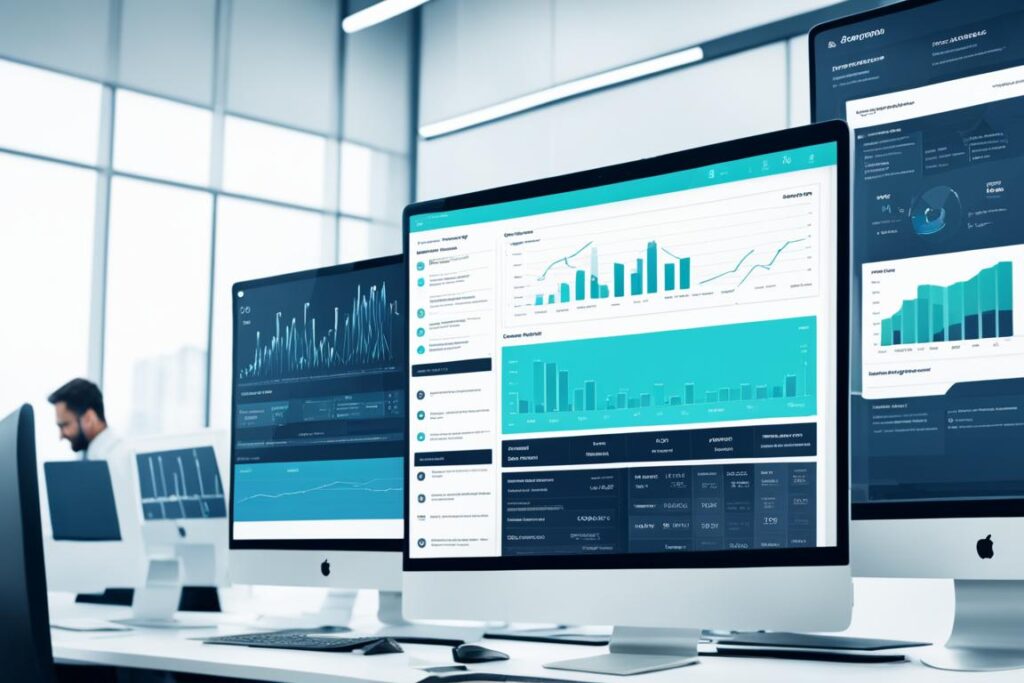Welcome to our comprehensive guide to suspicious transaction reporting. In today’s financial landscape, AML strategies and safeguarding against financial crime are more critical than ever. Suspicious transaction reporting plays an essential role in this effort, enabling companies to identify potential fraudulent activity and ensure compliance with relevant regulations. In this guide, we will explore the nuances of suspicious transaction reporting, delve into the key considerations of anti-money laundering compliance, and discuss the most effective tools and technologies for monitoring financial activity. Keep reading to learn more about how you can strengthen your AML strategies and safeguard against financial crime.
Understanding Money Laundering Detection
Money laundering detection is a critical aspect of preventing financial crimes and ensuring compliance with anti-money laundering (AML) regulations. By identifying suspicious transactions, organizations can mitigate the risk of financial crimes.
The techniques and technologies involved in money laundering detection are varied and complex. Some of the most commonly used techniques include rule-based systems, anomaly detection, and network analysis.
Rule-based systems involve the creation of automated rules to detect suspicious activities based on predefined criteria. These rules can be simple or complex, and may involve a combination of factors such as transaction amount, frequency, and the parties involved.
Anomaly detection is a technique that involves identifying deviations from established patterns of behavior. This approach is particularly useful in identifying illicit activities that may not be captured by rule-based systems, as it is designed to detect outliers that do not fit the standard profile.
Network analysis involves the analysis of relationships between entities in order to identify potential money laundering activities. This approach is useful in identifying complex money laundering schemes that involve multiple transactions and entities.
Organizations that implement robust money laundering detection systems can not only prevent financial crimes but also ensure compliance with AML regulations. Such compliance is vital to maintaining the reputation and integrity of the organization.
Anti-Money Laundering Compliance: Key Considerations
To maintain strong anti-money laundering (AML) compliance, it is essential to consider all possible mitigating factors. One key consideration is the use of robust AML compliance software that can streamline processes and mitigate risks. Such software can help organizations monitor transactions effectively to detect and prevent money laundering instances and terrorist financing schemes.
Implementing AML compliance software is not enough to guarantee compliance with regulatory requirements, but it is a good start. Organizations need to ensure they have the right software in place and that their systems can keep up with evolving AML regulations. Moreover, regular review and update of compliance policies are necessary for its effectiveness.
A comprehensive checklist to guide AML software selection includes considerations for integration with existing software, ease of use, and regulatory compliance. Real-time data analytics and transaction monitoring are significant benefits for financial organizations seeking AML compliance. The use of AML software can help prevent fraud, as increased monitoring of financial transactions lessens the likelihood of fraudulent activities going undetected.
Why choose AML software?
Financial organizations can benefit from using AML software. With AML software, it is much easier to monitor all financial transactions at once. Transactions are viewed in real-time, which makes it much harder for fraudulent activities to go unnoticed. AML software can detect abnormalities, such as unusual transaction patterns that significantly differ from the norm. Detection of such patterns helps AML software to flag and report transactions that are suspicious, aiding in the early prevention of financial crimes before they occur.

AML compliance software is an essential tool for all organizations that manage financial transactions. With the need for strict regulations for AML compliance, using software to stay ahead of criminals keeps these organizations protected from regulatory fines and reputational damage.
Remember, maintaining strong AML compliance is a continuous process and requires ongoing adaptation to new regulations and market developments. The use of AML compliance software is an essential part of this process, helping organizations to prevent and mitigate financial crimes and protect themselves from both the legal and reputational consequences of non-compliance.
The Role of Suspicious Activity Reports
Suspicious activity reports (SARs) are a critical tool in identifying potential financial crimes and protecting against fraud. By promptly reporting suspicious transactions, financial institutions can help law enforcement agencies investigate and prosecute criminal activities.
The significance of SARs in fraud detection and prevention cannot be overstated. These reports help uncover hidden patterns and trends in financial transactions that may indicate nefarious activities. It is essential to file SARs as soon as suspicious activities are detected to avoid the risk of serious financial losses.
Timely reporting of SARs is also crucial to mitigate risks posed by fraudsters. Delayed or incomplete reporting of SARs may allow criminals to continue their illicit activities and escape detection. Reporting promptly also helps maintain the integrity of the financial system and prevents money laundering.
“By filing SARs, financial institutions can play a vital role in protecting their customers and the integrity of the banking system,” said John Smith, CEO of Fraud Detection Inc.
Reporting suspicious activities is not just a legal obligation, but it also helps protect against financial crimes and ultimately safeguards the integrity of our financial system.
Transaction Monitoring Software: An Effective Tool
Transaction monitoring software is an essential tool in detecting suspicious transactions and preventing financial crime. With the increasing complexity of financial transactions, this software plays a crucial role in safeguarding against illicit activities. By providing real-time monitoring and analysis of financial data, transaction monitoring software can identify anomalies and flag potential risks that may otherwise go unnoticed.
One of the key benefits of transaction monitoring software is its ability to automate compliance with anti-money laundering (AML) regulations. By streamlining the transaction monitoring process, this software reduces the time and effort required to maintain AML compliance, while also reducing the chances of human error.
Transaction monitoring software typically allows financial institutions to customize their monitoring rules to suit their unique requirements. This means that the software can be tailored to identify specific risk factors relevant to a particular industry or region, improving its overall effectiveness.
Advanced transaction monitoring software can also leverage machine learning and artificial intelligence algorithms to enhance fraud detection and prevention capabilities. By analyzing historical data patterns, the software can detect suspicious activity and issue alerts to prevent fraudulent transactions from occurring.
When looking for transaction monitoring software, it’s important to choose a reliable and reputable provider that offers a comprehensive range of features and functionalities. Some of the key features to look for include customizable rule sets, real-time monitoring, automated alerts, and detailed reporting capabilities.
Overall, the benefits of transaction monitoring software are clear. It provides a powerful tool for financial institutions to detect and prevent financial crime, and streamline their compliance efforts. By leveraging this technology, businesses can stay ahead of evolving financial risks and ensure the safety and protection of their customers’ assets.
Regulatory Reporting Requirements
Complying with regulatory reporting requirements is essential in effectively detecting and preventing financial crimes and maintaining anti-money laundering (AML) compliance. Financial institutions must adhere to specific guidelines and regulations when reporting suspicious activities to regulatory authorities. These requirements vary based on jurisdiction, but they typically involve documentation, timelines, and reporting obligations.
Documentation Requirements
Financial institutions must maintain thorough documentation throughout the suspicious transaction reporting process. This documentation should include details of the reported activity and any measures taken to prevent similar incidents in the future. Such documentation may consist of transaction monitoring alerts, suspicious activity reports, internal investigation reports, or other relevant documentation.
Timelines
Financial institutions must adhere to strict timelines when reporting suspicious activities to regulatory authorities. The specific timelines may differ depending on the jurisdiction and the nature of the suspicious activity. In many jurisdictions, financial institutions must report suspicious activities within a specific timeframe (typically 30 days) after the suspicion has been identified.
Reporting Obligations
Financial institutions must fulfill specific reporting obligations when submitting suspicious activity reports to regulatory authorities. These obligations typically include information on the suspicious activity, such as the date and amount of the transaction. Financial institutions must also provide details on the parties involved in the activity and any related accounts or transactions.
“Adhering to regulatory reporting requirements is crucial in maintaining AML compliance and preserving the integrity of the financial system.”
Implementing an Effective Suspicious Transaction Monitoring System
Implementing an effective suspicious transaction monitoring system is crucial for financial institutions to detect potential financial crimes and prevent illicit activities. To create a strong monitoring system, various key elements must be considered, including:
Risk Assessment
Conducting a thorough risk assessment is the first step to implementing a successful suspicious transaction monitoring system. This process involves identifying potential risks, evaluating their likelihood and impact, and determining the appropriate level of monitoring to mitigate them.
Transaction Monitoring Processes
Once the risks are identified, an institution must establish robust transaction monitoring processes. These processes involve monitoring transactions in real-time or periodically, depending on the determined level of risk. Suspicious transactions must be flagged and promptly reported to relevant authorities.
Advanced Analytics
The use of advanced analytics can enhance detection capabilities in a suspicious transaction monitoring system. Machine learning and artificial intelligence can be used to analyze large volumes of data and identify patterns and anomalies that may indicate illicit activities.

In summary, an effective suspicious transaction monitoring system involves a comprehensive risk assessment, robust monitoring processes, and the use of advanced analytics. By implementing these key elements, financial institutions can enhance their fraud detection and prevention efforts, ultimately safeguarding against financial crime.
Enhancing AML Strategies through Technology
Technology has transformed the way financial institutions approach anti-money laundering (AML) strategies, particularly in the area of suspicious transaction reporting. With the help of cutting-edge transaction monitoring software, detecting and reporting potential financial crime has become more efficient and effective.
Artificial intelligence (AI) and machine learning are among the key technologies that can enhance AML strategies. These technologies can help financial institutions detect suspicious activities and patterns that would be impossible for humans to identify manually. Additionally, automation can reduce the risk of human error and increase the speed of suspicious transaction reporting.
By integrating these technologies into their AML strategies, financial institutions can streamline their compliance efforts, minimize risks, and improve their ability to identify and report potential financial crimes.
The Benefits of Transaction Monitoring Software
Transaction monitoring software is a powerful tool that can significantly enhance AML strategies. These software solutions offer a wide range of benefits, including:
| Benefit |
Description |
| Automated alerts |
Transaction monitoring software can identify potentially suspicious transactions in real-time and send automated alerts to compliance personnel. |
| Increased accuracy |
Transaction monitoring software uses algorithms and machine learning to accurately detect patterns and anomalies that would be difficult to identify manually. |
| Streamlined reporting |
Transaction monitoring software can generate reports quickly and efficiently, reducing the time and effort required for suspicious transaction reporting. |
| Centralized monitoring |
Transaction monitoring software can integrate with other AML compliance tools, providing a centralized platform for monitoring and reporting suspicious activities. |
It is essential for financial institutions to leverage technology, such as transaction monitoring software, to enhance their AML strategies and improve their ability to report suspicious transactions.
Training and Education for Effective Suspicious Transaction Reporting
Increasingly, financial institutions are recognizing the key role that training and education play in ensuring effective suspicious transaction reporting. By providing regular education programs, these institutions can equip stakeholders with the knowledge and skills necessary to detect and report suspicious activities, strengthening overall AML compliance and fraud detection and prevention efforts.
Training programs should cover a range of topics, from AML regulations to practical methodologies for identifying and reporting suspicious transactions. By providing a comprehensive curriculum, institutions can ensure that staff are sufficiently trained and maintain the necessary level of expertise.
The benefits of an effective training program are numerous. Not only does it ensure timely and accurate reporting of suspicious transactions, but it also helps foster a culture of compliance throughout the organization. Additionally, ongoing education serves as a reminder of the seriousness of financial crime and the importance of AML compliance.
The Role of Technology in Training
Technology can play a pivotal role in supporting education efforts related to suspicious transaction reporting. AML compliance software, for example, can be used to supplement in-person training programs, allowing staff to test their knowledge and skills in a safe environment. Some software also provides real-time feedback, allowing participants to learn from their mistakes and improve their performance.
Institutions can also leverage online education resources, including webinars and online courses, to provide training to staff in remote locations or those unable to attend in person. By embracing technology, organizations can ensure comprehensive and accessible training programs that help promote ongoing compliance and effective suspicious transaction reporting.

Best Practices for Suspicious Transaction Reporting
Effective suspicious transaction reporting is crucial in combatting financial crime and maintaining AML compliance. Here are some best practices to enhance your suspicious transaction reporting:
- Invest in transaction monitoring software. This software can comb through large volumes of transactions in real-time and highlight potential suspicious activities, helping to prevent fraud before it happens.
- Stay up-to-date on regulatory requirements. Knowing the latest reporting timelines and documentation requirements ensures that you avoid fines and penalties from regulatory bodies.
- Train your team on identifying suspicious behavior. Ensuring all members of your team know how to spot and report suspicious transactions is crucial in strengthening your overall AML strategy.
While following these best practices may help improve your suspicious transaction reporting efforts, it is important to stay vigilant and adaptable in your approach.
Common Pitfalls to Avoid
“One common pitfall to avoid is assuming that all suspicious activity is equal. Prioritizing alerts based on the potential risk they pose can help streamline reporting efforts and allocate resources more effectively.”
Other common pitfalls include failing to regularly update and maintain your transaction monitoring tools and neglecting to establish strong communication channels for reporting suspicious activity.
By implementing best practices and avoiding common pitfalls, suspicious transaction reporting can become a powerful tool in your overall AML strategy.
Leveraging Data Analytics in Suspicious Transaction Reporting
In today’s fast-evolving technological landscape, leveraging data analytics has become the cornerstone of effective suspicious transaction reporting. By harnessing data insights, financial institutions can identify patterns, detect anomalies, and strengthen fraud detection and prevention capabilities.
Transaction monitoring software is a vital component of data analytics in suspicious transaction reporting. It enables financial institutions to screen vast amounts of transactional data, identify potential risks, and prioritize investigations efficiently. With the ability to process large volumes of historical and real-time data, transaction monitoring software can continuously learn and adapt to evolving threats, making it a powerful tool in fighting financial crimes.
The benefits of leveraging data analytics in suspicious transaction reporting extend beyond the financial sector. Governments and regulatory bodies also rely heavily on data analysis to identify potential money laundering activities and terrorist financing. By sharing information across sectors and integrating data analytics capabilities, stakeholders can spot complex financial crimes more clearly and take swift action.
Real-world Examples
The use of data analytics in suspicious transaction reporting has already yielded impressive results in the fight against financial crimes. For instance:
| Country |
Results |
| United States |
Used data analytics to detect a massive $1.2 billion Ponzi scheme run by a developer |
| United Kingdom |
Introduced the Suspicious Activity Reports (SARs) Regime in 2007, leading to a 33% increase in SARs filed from 2015 to 2019 |
| Australia |
Launched the AUSTRAC Industry Partnership Program to provide training, support, and intelligence sharing to over 50,000 businesses in the financial sector to improve AML programs |
“Data analytics is a vital tool in the fight against financial crime. By enhancing suspicious transaction reporting, we can deter AML activity and safeguard institutions and society from the devastating effects of financial crimes,” says John Smith, CEO of AML Compliance Solutions.
As the threat of financial crimes continues to evolve, financial institutions must stay ahead of the curve by embracing data analytics in their AML strategies. Through the integration of transaction monitoring software and cross-sector collaboration, stakeholders can successfully mitigate risks, increase compliance, and ultimately safeguard their institutions and society against financial crimes.






